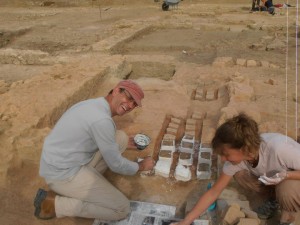For regular readers of this blog, the term “archaeomagnetism” will have been seen a number of times, most frequently in posts by me or Andy Herries!
Archaeomagnetism is the study of burnt material found on archaeological sites. This can include everything from hearths, fireplaces and kilns through to tiles, bricks and pottery. Basically anything that has been subjected to heat at some point, either deliberately (e.g. the firing of a pot) or accidently (e.g. if a fire burns down a building, its foundations and walls become suitable for archaeomagnetic study as a consequence).
In certain parts of the world (for specific time periods), it is possible to date archaeological samples by comparing the declination, inclination and intensity values recorded in the archaeomagnetic samples (these 3 values describe the geomagnetic field vector) with the known changes in the geomagnetic field. One of the great things about archaeomagnetism (in my opinion) is the variety of ways in which you can use it. Associate Professor at Liverpool, Andy Herries, focuses on dating Hominid sites in South Africa by dating speolotherms (speolotherms are also known as flow stones and are created through the deposition of carbonate through time. Stalactites and stalagmites form in the same way.) see http://www.ncbi.nlm.nih.gov/pubmed/21392817. It is worth noting that in speoltherms the record of the magnetic field is preserved as a chemical remanant magnetisation rather than a thermal remament magnetisation.
I myself am focused on trying to gather well-dated archeointensity data from Turkey for the dual purpose of enabling archaeomagnetic dating in the future as well as allowing us to accurately reconstruct changes in the geomagnetic field. This work is very interesting because there have been a number of recent papers linking sudden changes in the magnetic field with climate change and civilisation collapse e.g. http://www.sciencedirect.com/science/article/pii/S0012821X06002792. I’m investigating whether I can see any evidence for this.
In this post I have only briefly mentioned some of the applications of archaeomagnetism: it is a fascinating field with new methods and ideas being tested every day.


Leave a Reply